Detection of Pb2+ in Tea Using Aptamer Labeled with AIEgen Nanospheres Based on MOFs Sensors
Abstract
:1. Introduction
2. Materials and Methods
2.1. Chemical Reagents and Experimental Materials
2.2. Laboratory Apparatus
2.3. Aptamers Labelled with AIEgen Nanospheres (AIEgen-DNA)
2.4. Tea Treatment
3. Result and Discussion
3.1. Characterisation of P.S. Nanospheres and AIEgen NPs
3.2. Experimental Condition Optimisation
3.2.1. Optimal Concentration Selection of AIEgen-DNA
3.2.2. Optimal Concentration of dsDNA
3.2.3. Optimal Concentration of Zr-MOFs
3.2.4. Reaction Time Optimisation
3.3. Sensitivity Detection
3.4. Optimum Concentration of PEG
3.5. Sensitivity Analysis after PEG Was Added
3.6. Selective Analysis
3.7. Stability of Practical Application
3.8. Detection of Lead Ion in Tea
4. Conclusions
Author Contributions
Funding
Institutional Review Board Statement
Informed Consent Statement
Data Availability Statement
Conflicts of Interest
References
- Dou, Q.P. Tea in health and disease. Nutrients 2019, 11, 929. [Google Scholar] [CrossRef] [PubMed]
- Khoshbin, Z.; Housaindokht, M.R.; Verdian, A.; Bozorgmehr, M.R. Simultaneous detection and determination of mercury (II) and lead (II) ions through the achievement of novel functional nucleic acid-based biosensors. Biosens. Bioelectron. 2018, 116, 130–147. [Google Scholar] [PubMed]
- Izah, S.C.; Chakrabarty, N.; Srivastav, A.L. A review on heavy metal concentration in potable water sources in Nigeria: Human health effects and mitigating measures. Expo Health 2016, 8, 285–304. [Google Scholar] [CrossRef]
- Terán, E.J.; Montes, M.L.; Rodríguez, C.; Martino, L.; Quiroga, M.; Landa, R.; Torres Sánchez, R.M.; Díaz Pace, D.M. Assessment of sorption capability of montmorillonite clay for lead removal from water using laser-induced breakdown spectroscopy and atomic absorption spectroscopy. Microchem. J. 2019, 144, 159–165. [Google Scholar] [CrossRef]
- He, C.; Cheng, G.; Zheng, C.; Wu, L.; Lee, Y.-I.; Hou, X. Photochemical vapour generation and in situ preconcentrations for determination of mercury by graphite furnace atomic absorption spectrometry. Anal. Methods 2015, 7, 3015–3021. [Google Scholar] [CrossRef]
- Costa, R.A.; Dos Santos, N.A.; Corrêa, T.S.M.; Wyatt, N.L.P.; Chamoun, C.A.; Carneiro, M.; Romão, W. Detection of Pb, Ba, and Sb in Cadaveric Maggots and Pupae by ICP-MS. J. Forensic Sci. 2020, 65, 2188–2193. [Google Scholar] [CrossRef]
- Shamsipur, M.; Farzin, L.; Amouzadeh Tabrizi, M.; Sheibani, S. Functionalized Fe3O4/graphene oxide nanocomposites with hairpin aptamers for the separation and preconcentration of trace Pb2+ from biological samples prior to determination by ICP MS. Mater. Sci. Eng. C 2017, 77, 459–469. [Google Scholar] [CrossRef]
- Xie, M.-R.; Cai, Y.; Liu, Y.-Q.; Wu, Z.-Y. Sensitive colourimetric detection of Pb2+ by geometric field amplification and surface plasmon resonance visualization. Talanta 2020, 212, 120749. [Google Scholar] [CrossRef]
- Sun, Q.; Wang, J.; Tang, M.; Huang, L.; Zhang, Z.; Liu, C.; Lu, X.; Hunter, K.W.; Chen, G. A new electrochemical system based on a flow-field shaped solid electrode and 3D-printed thin-layer flow cell: Detection of Pb2+ ions by continuous flow accumulation square-wave anodic stripping voltammetry. Anal. Chem. 2017, 89, 5024–5029. [Google Scholar] [CrossRef]
- Santos, N.R.; Bandeira, M.J.; Bah, H.A.F.; Rodrigues, J.L.G.; Cardoso, M.S.; Rocha, A.R.; Menezes-Filho, J.A. Zinc-protoporphyrin determination by HPLC with fluorescence detection as a biomarker of lead effect in artisanal pottery workers. Biomed. Chromatogr. BMC 2021, 35, e4983. [Google Scholar] [CrossRef]
- Sitko, R.; Janik, P.; Zawisza, B.; Talik, E.; Margui, E.; Queralt, I. Green approach for ultratrace determination of divalent metal ions and arsenic species using total-reflection X-ray fluorescence spectrometry and mercapto-modified graphene oxide nanosheets as a novel adsorbent. Anal. Chem. 2015, 87, 3535–3542. [Google Scholar] [CrossRef] [PubMed]
- Ravikumar, A.; Panneerselvam, P.; Radhakrishnan, K.; Morad, N.; Anuradha, C.D.; Sivanesan, S. DNAzyme based amplified biosensor on ultrasensitive fluorescence detection of Pb (II) ions from aqueous system. J. Fluoresc. 2017, 27, 2101–2109. [Google Scholar] [CrossRef] [PubMed]
- Wang, L.; Zhang, Y.; Wu, A.; Wei, G. Designed graphene-peptide nanocomposites for biosensor applications: A review. Anal. Chim. Acta 2017, 985, 24–40. [Google Scholar] [CrossRef] [PubMed]
- Peña-Bahamonde, J.; Nguyen, H.N.; Fanourakis, S.K.; Rodrigues, D.F. Recent advances in graphene-based biosensor technology with applications in life sciences. J. Nanobiotechnol. 2018, 16, 75. [Google Scholar] [CrossRef] [PubMed]
- Chen, X.; Xu, K.; Li, J.; Yang, M.; Li, X.; Chen, Q.; Lu, C.; Yang, H. Switch-conversional ratiometric fluorescence biosensor for miRNA detection. Biosens. Bioelectron. 2020, 155, 112104. [Google Scholar] [CrossRef]
- Zhang, Y.; Zhang, C.; Ma, R.; Du, X.; Dong, W.; Chen, Y.; Chen, Q. An ultra-sensitive Au nanoparticles functionalized DNA biosensor for electrochemical sensing of mercury ions. Mater. Sci. Eng. C Mater. Biol. Appl. 2017, 75, 175–181. [Google Scholar] [CrossRef]
- Ao, H.; Qian, Z.; Zhu, Y.; Zhao, M.; Tang, C.; Huang, Y.; Feng, H.; Wang, A. A fluorometric biosensor based on functional Au/Ag nanoclusters for real-time monitoring of tyrosinase activity. Biosens. Bioelectron. 2016, 86, 542–547. [Google Scholar] [CrossRef]
- Li, J.; Yang, K.; Wu, Z.; Li, X.; Duan, Q. Nitrogen-doped porous carbon-based fluorescence sensor for detecting ZIKV RNA sequences: Fluorescence image analysis. Talanta 2019, 205, 120091. [Google Scholar] [CrossRef]
- Cui, H.F.; Zhang, T.T.; Lv, Q.Y.; Song, X.; Zhai, X.J.; Wang, G.G. An acetylcholinesterase biosensor based on doping Au nanorod@SiO2 nanoparticles into TiO2-chitosan hydrogel for detection of organophosphate pesticides. Biosens. Bioelectron. 2019, 141, 111452. [Google Scholar] [CrossRef]
- Li, J.; Jin, Y.; Wang, Y.; Zhao, Y.; Su, H. Detecting Pb2+ by a ‘turn-on’ fluorescence sensor based on DNA functionalized magnetic nanocomposites. Nanotechnology 2021, 33, 1361–6528. [Google Scholar] [CrossRef]
- Enrichi, F.; Cattaruzza, E.; Ferrari, M.; Gonella, F.; Ottini, R.; Riello, P.; Righini, G.C.; Enrico, T.; Vomiero, A.; Zur, L. Ag-sensitized Yb3+ emission in glass-ceramics. Micromachines 2018, 9, 380. [Google Scholar] [CrossRef] [PubMed]
- Mei, J.; Hong, Y.; Lam, J.W.; Qin, A.; Tang, Y.; Tang, B.Z. Aggregation-induced emission: The whole is more brilliant than the parts. Adv. Mater. Deerfield Beach Fla. 2014, 26, 5429–5479. [Google Scholar] [CrossRef] [PubMed]
- Han, T.; Feng, X.; Tong, B.; Shi, J.; Chen, L.; Zhi, J.; Dong, Y. A novel “turn-on” fluorescent chemosensor for the selective detection of Al3+ based on aggregation-induced emission. Chem. Commun. 2012, 48, 416–418. [Google Scholar] [CrossRef] [PubMed]
- Leung, C.W.T.; Hong, Y.; Chen, S.; Zhao, E.; Lam, J.W.Y.; Tang, B.Z. A photostable AIE luminogen for specific mitochondrial imaging and tracking. J. Am. Chem. Soc. 2013, 135, 62–65. [Google Scholar] [CrossRef] [PubMed]
- Yuan, Y.; Zhang, C.J.; Liu, B. A photoactivatable AIE polymer for light-controlled gene delivery: Concurrent endo/lysosomal escape and DNA unpacking. Angew. Chem. Int. Ed. 2015, 54, 11419–11423. [Google Scholar] [CrossRef]
- Liu, Z.; Zou, H.; Zhao, Z.; Zhang, P.; Shan, G.G.; Kwok, R.T.K.; Lam, J.W.Y.; Zheng, L.; Tang, B.Z. Tuning organelle specificity and photodynamic therapy efficiency by molecular function design. ACS Nano 2019, 13, 11283–11293. [Google Scholar] [CrossRef]
- Hu, F.; Xu, S.; Liu, B. Photosensitizers with aggregation-induced emission: Materials and Biomedical Applications. Adv. Mater. Deerfield Beach Fla. 2018, 30, e1801350. [Google Scholar] [CrossRef]
- Mei, J.; Leung, N.L.; Kwok, R.T.; Lam, J.W.; Tang, B.Z. Aggregation-induced emission: Together we shine, united we soar! Chem. Rev. 2015, 115, 11718–11940. [Google Scholar] [CrossRef]
- Li, M.; Lam, J.W.Y.; Mahtab, F.; Chen, S.; Zhang, W.; Hong, Y.; Xiong, J.; Zheng, Q.; Tang, B.Z. Biotin-decorated fluorescent silica nanoparticles with aggregation-induced emission characteristics: Fabrication, cytotoxicity and biological applications. J. Mater. Chem. B 2013, 1, 676–684. [Google Scholar] [CrossRef]
- Zhang, Q.; Yin, B.; Hao, J.; Ma, L.; Huang, Y.; Shao, X.; Li, C.; Chu, Z.; Yi, C.; Wong, S.H.D.; et al. An AIEgen/graphene oxide nanocomposite (AIEgen@GO)-based two-stage “turn-on” nucleic acid biosensor for rapid detection of SARS-CoV-2 viral sequence. Aggregate 2022, e195. [Google Scholar] [CrossRef]
- Ma, K.; Zhang, F.; Sayyadi, N.; Chen, W.; Anwer, A.G.; Care, A.; Xu, B.; Tian, W.; Goldys, E.M.; Liu, G. “Turn-on” fluorescent aptasensor based on AIEgen labelling for the localization of IFN-γ in live cells. ACS Sens. 2018, 3, 320–326. [Google Scholar] [CrossRef]
- Mu, F.; He, J.; Fan, F.; Shi, G. Dual-emission fluorescence biosensing of vancomycin based on AIEgen-peptide conjugates and aptamer-modified Au nanoclusters. Anal. Chim. Acta 2021, 1150, 238177. [Google Scholar] [CrossRef] [PubMed]
- Liu, Q.; Dordick, J.S.; Dinu, C.Z. Metal-organic framework-based composite for photocatalytic detection of prevalent pollutant. ACS Appl. Mater. Interfaces 2019, 11, 31049–31059. [Google Scholar] [CrossRef]
- Li, G.; Zhao, S.; Zhang, Y.; Tang, Z. Metal-organic frameworks encapsulating active nanoparticles as emerging composites for catalysis: Recent progress and perspectives. Adv. Mater. 2018, 30, e1800702. [Google Scholar] [CrossRef] [PubMed]
- Wang, S.; McGuirk, C.M.; Ross, M.B.; Wang, S.; Chen, P.; Xing, H.; Liu, Y.; Mirkin, C.A. General and direct method for preparing oligonucleotide-functionalized metal-organic framework nanoparticles. J. Am. Chem. Soc. 2017, 139, 9827–9830. [Google Scholar] [CrossRef] [PubMed]
- Hu, P.-P.; Liu, N.; Wu, K.-Y.; Zhai, L.-Y.; Xie, B.-P.; Sun, B.; Duan, W.-J.; Zhang, W.-H.; Chen, J.-X. Successive and specific detection of Hg2+ and I− by a DNA@MOF biosensor: Experimental and simulation studies. Inorg. Chem. 2018, 57, 8382–8389. [Google Scholar] [CrossRef]
- Huang, N.H.; Liu, Y.; Li, R.T.; Chen, J.; Hu, P.P.; Young, D.J.; Chen, J.X.; Zhang, W.H. Sequential Ag+/biothiol and synchronous Ag+/Hg2+ biosensing with zwitterionic Cu2+-based metal-organic frameworks. Analyst 2020, 145, 2779–2788. [Google Scholar] [CrossRef]
- Teh, H.B.; Li, H.; Yau Li, S.F. Highly sensitive and selective detection of Pb2+ ions using a novel and simple DNAzyme-based quartz crystal microbalance with dissipation biosensor. Analyst 2014, 139, 5170–5175. [Google Scholar] [CrossRef]
- Hu, X.; Zhang, P.; Wang, D.; Jiang, J.; Chen, X.; Liu, Y.; Zhang, Z.; Tang, B.Z.; Li, P. AIEgens enabled ultrasensitive point-of-care test for multiple targets of food safety: Aflatoxin B(1) and cyclopiazonic acid as an example. Biosens. Bioelectron. 2021, 182, 113188. [Google Scholar] [CrossRef]
- Sun, X.; Liu, Z.; Welsher, K.; Robinson, J.T.; Goodwin, A.; Zaric, S.; Dai, H. Nano-Graphene Oxide for Cellular Imaging and Drug Delivery. Nano Res. 2008, 1, 203–212. [Google Scholar] [CrossRef] [Green Version]
- Zhang, K.; Zhu, G.; Wei, Y.; Zhang, L.; Shen, Y. Engineering an upconversion luminescence sensing platform based on the competition effect for mercury-ion monitoring in green tea. J. Agric. Food Chem. 2021, 69, 8565–8570. [Google Scholar] [CrossRef] [PubMed]
- Szymczycha-Madeja, A.; Welna, M.; Pohl, P. Determination of essential and non-essential elements in green and black teas by FAAS and ICP OES simplified—Multivariate classification of different tea products. Microchem. J. 2015, 121, 122–129. [Google Scholar] [CrossRef]
- Lin, W.; Ma, G.; Ji, F.; Zhang, J.; Wang, L.; Sun, H.; Chen, S. Biocompatible long-circulating star carboxy betaine polymers. J. Mater. Chem. B 2015, 3, 440–448. [Google Scholar] [CrossRef]
- Cui, M.; Song, Z.; Wu, Y.; Guo, B.; Fan, X.; Luo, X. A highly sensitive biosensor for tumour maker alpha-fetoprotein based on poly(ethylene glycol) doped conducting polymer PEDOT. Biosens. Bioelectron. 2016, 79, 736–741. [Google Scholar] [CrossRef] [PubMed]
- Wang, W.; Fan, X.; Xu, S.; Davis, J.J.; Luo, X. Low fouling label-free DNA sensor based on polyethylene glycols decorated with gold nanoparticles for the detection of breast cancer biomarkers. Biosens. Bioelectron. 2015, 71, 51–56. [Google Scholar] [CrossRef] [PubMed]
- González-Fernández, E.; Avlonitis, N.; Murray, A.F.; Mount, A.R.; Bradley, M. Methylene blue not ferrocene: Optimal reporters for electrochemical detection of protease activity. Biosens. Bioelectron. 2016, 84, 82–88. [Google Scholar] [CrossRef] [PubMed]
- Martins, V.C.; Cardoso, F.A.; Freitas, P.P.; Fonseca, L.P. Picomolar detection limit on a magnetoresistive biochip after optimization of a thiol-gold based surface chemistry. J. Nanosci. Nanotechnol. 2010, 10, 5994–6002. [Google Scholar] [CrossRef]
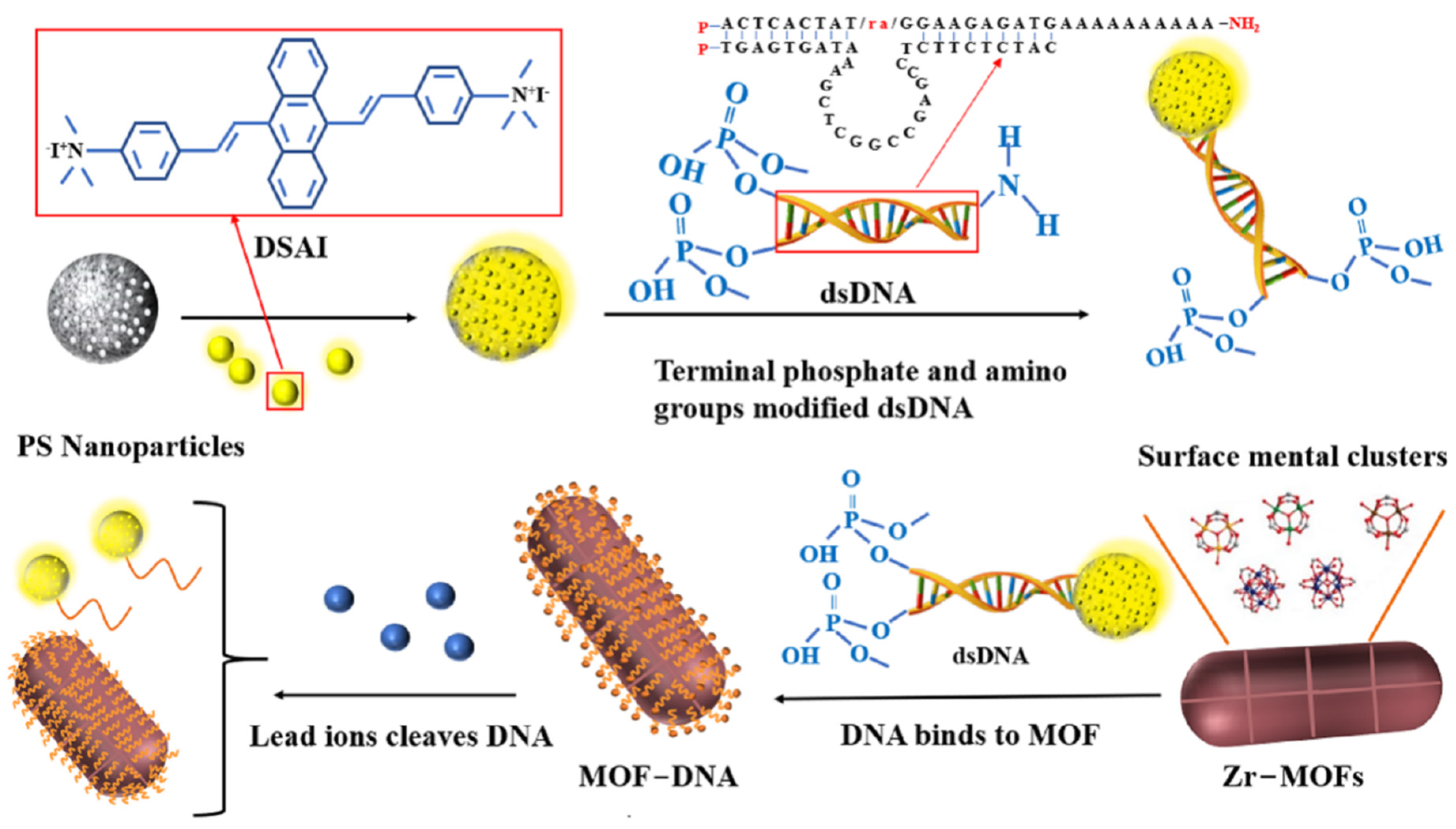

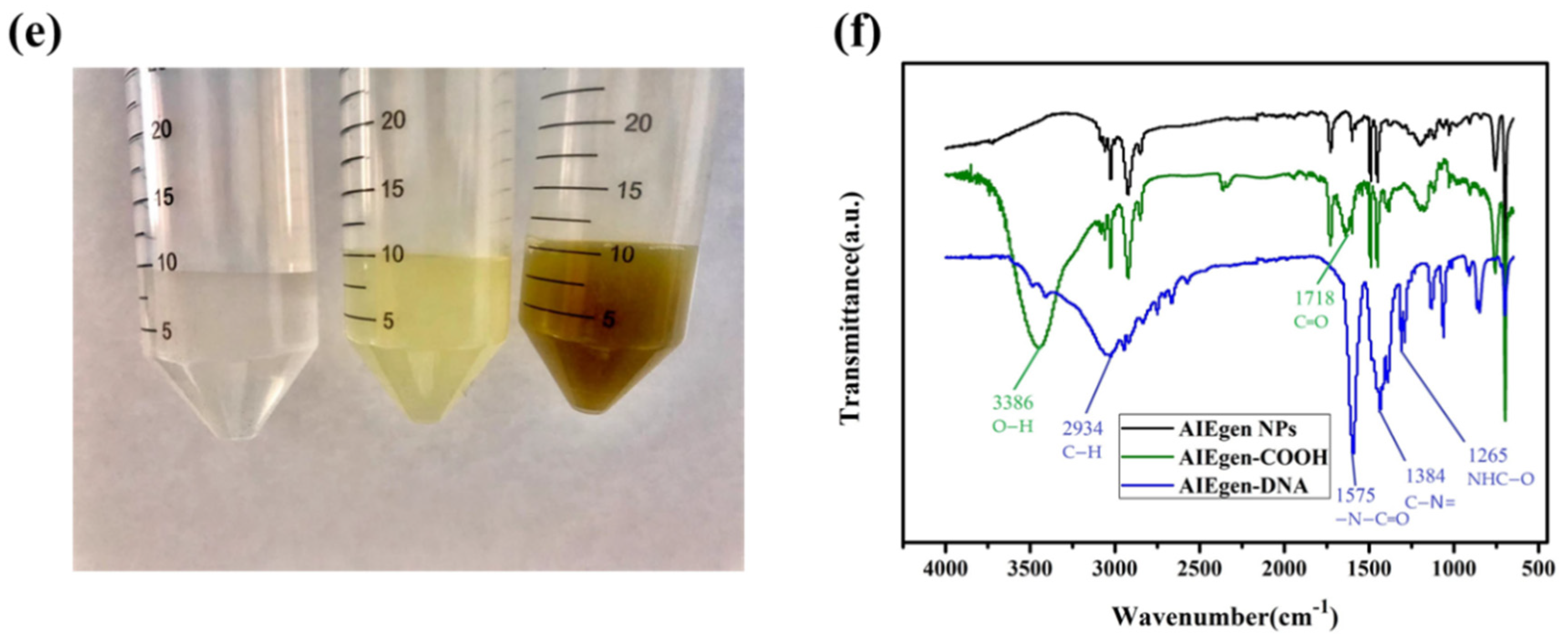
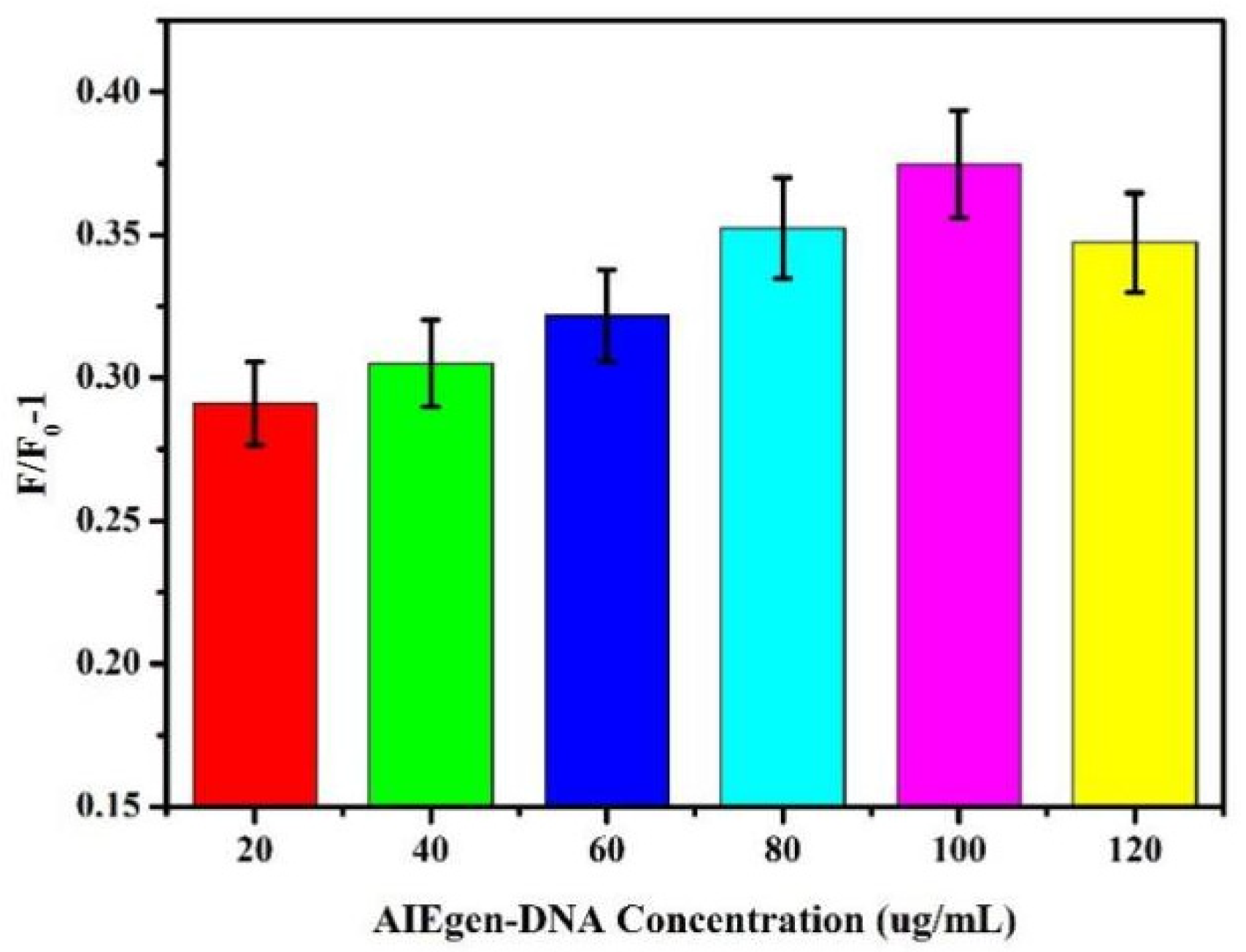
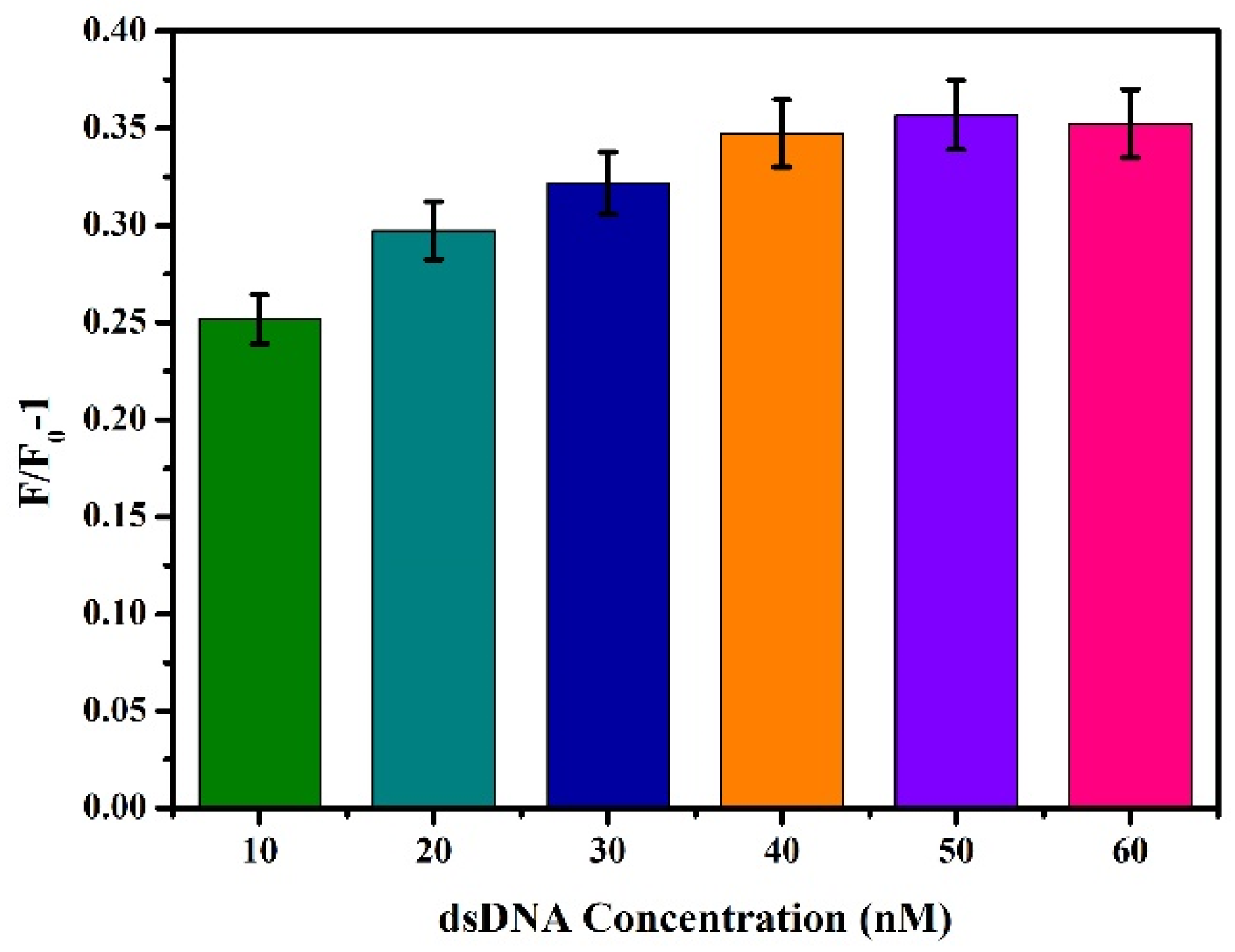
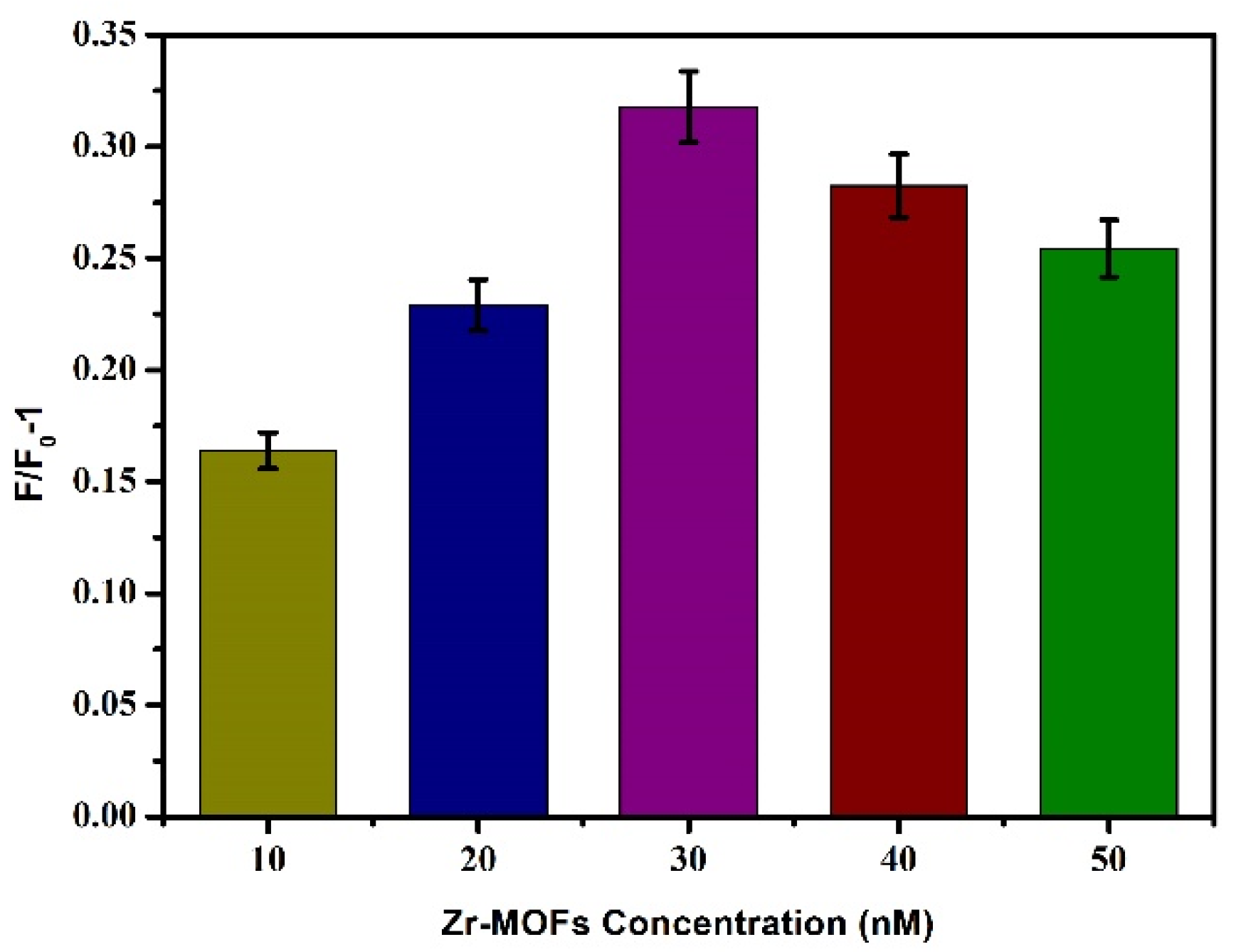
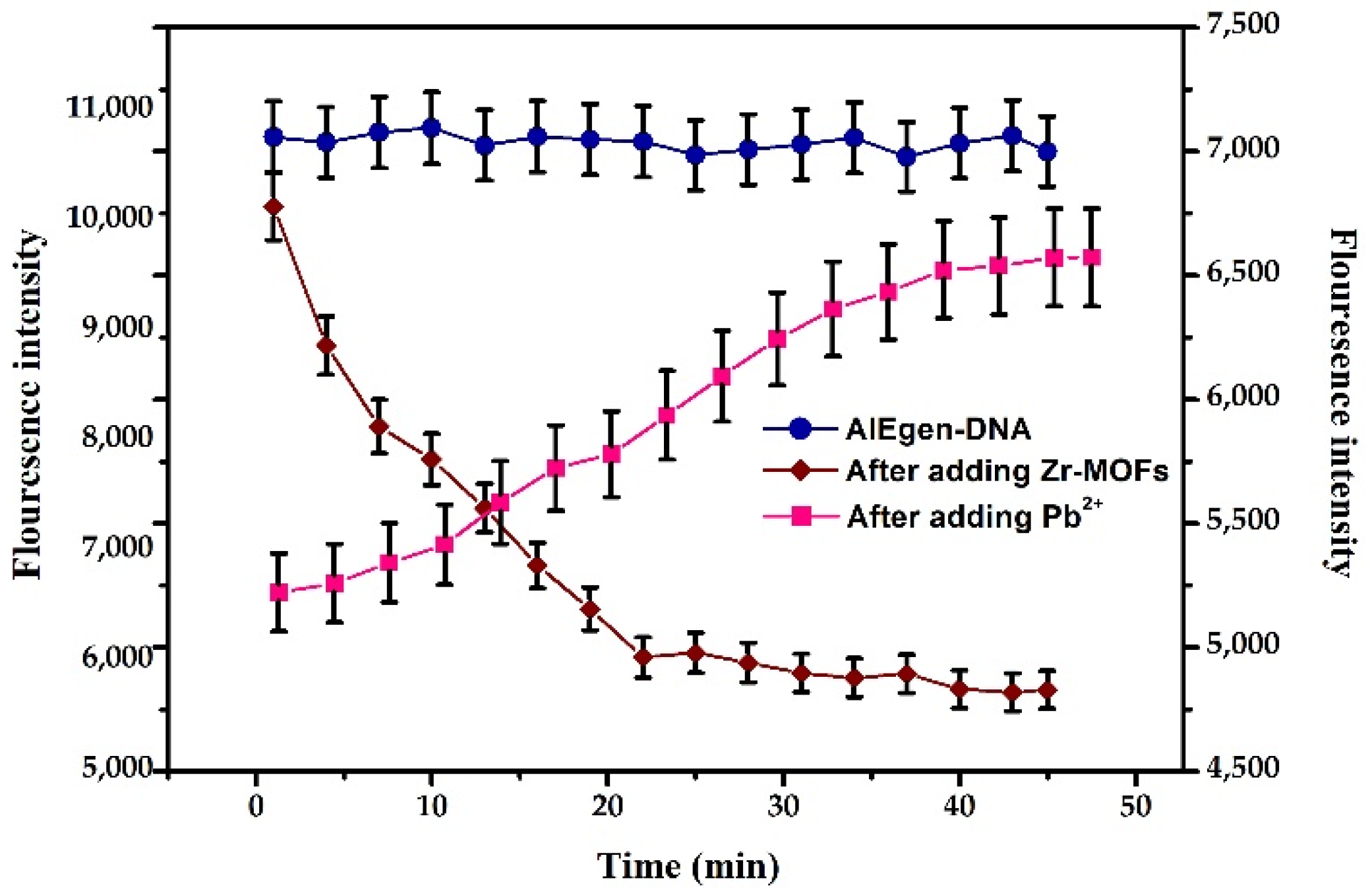


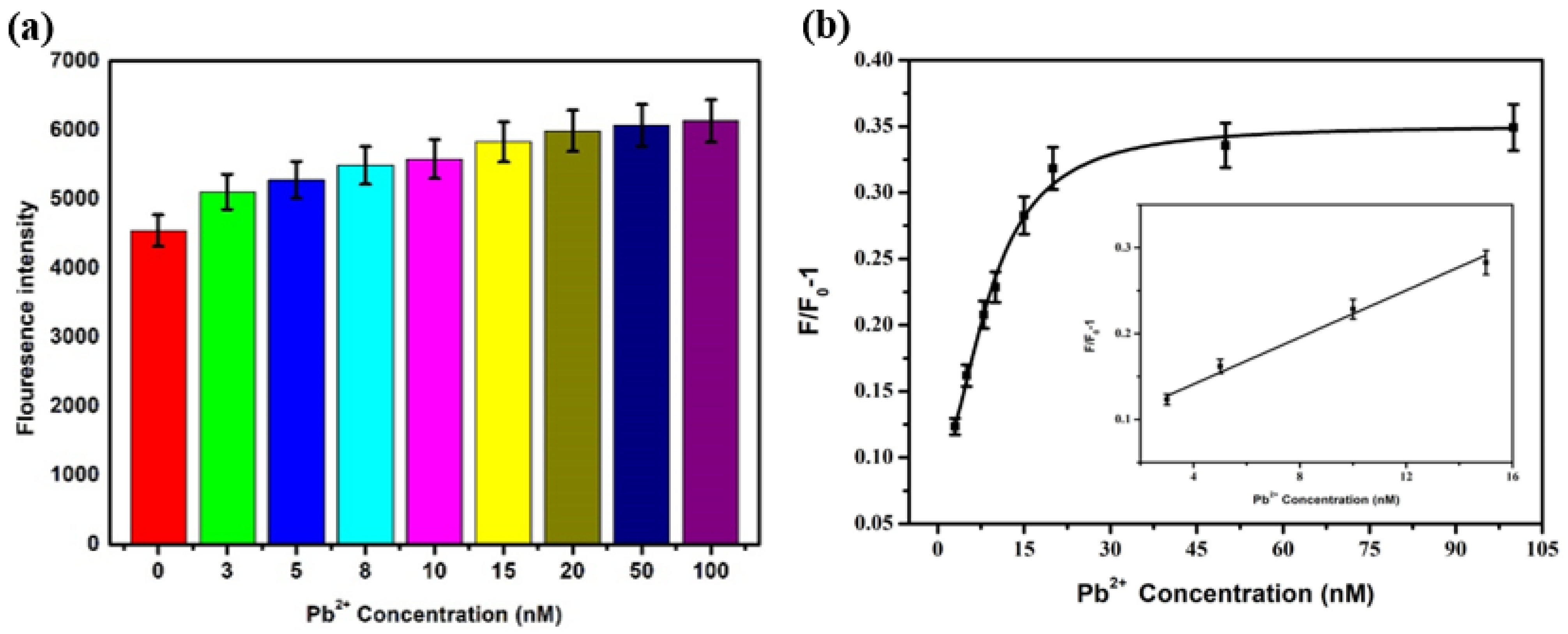


| Samples | Added (ng/mL) | Obtained (ng/mL) | Recovery (%) | S.D. (%) | RSD (%) |
|---|---|---|---|---|---|
| 1 | 3 | 3.003213 | 100.107108 | 0.0797 | 0.729 |
| 2 | 5 | 5.205697 | 104.11394 | 0.3771 | 2.649 |
| 3 | 10 | 10.372185 | 103.72185 | 0.4003 | 1.738 |
Publisher’s Note: MDPI stays neutral with regard to jurisdictional claims in published maps and institutional affiliations. |
© 2022 by the authors. Licensee MDPI, Basel, Switzerland. This article is an open access article distributed under the terms and conditions of the Creative Commons Attribution (CC BY) license (https://creativecommons.org/licenses/by/4.0/).
Share and Cite
Gao, L.; Deng, Y.; Liu, H.; Solomon, K.; Zhang, B.; Cai, H. Detection of Pb2+ in Tea Using Aptamer Labeled with AIEgen Nanospheres Based on MOFs Sensors. Biosensors 2022, 12, 745. https://doi.org/10.3390/bios12090745
Gao L, Deng Y, Liu H, Solomon K, Zhang B, Cai H. Detection of Pb2+ in Tea Using Aptamer Labeled with AIEgen Nanospheres Based on MOFs Sensors. Biosensors. 2022; 12(9):745. https://doi.org/10.3390/bios12090745
Chicago/Turabian StyleGao, Li, Yixi Deng, Haolu Liu, King Solomon, Bianjiang Zhang, and Huimei Cai. 2022. "Detection of Pb2+ in Tea Using Aptamer Labeled with AIEgen Nanospheres Based on MOFs Sensors" Biosensors 12, no. 9: 745. https://doi.org/10.3390/bios12090745
APA StyleGao, L., Deng, Y., Liu, H., Solomon, K., Zhang, B., & Cai, H. (2022). Detection of Pb2+ in Tea Using Aptamer Labeled with AIEgen Nanospheres Based on MOFs Sensors. Biosensors, 12(9), 745. https://doi.org/10.3390/bios12090745





